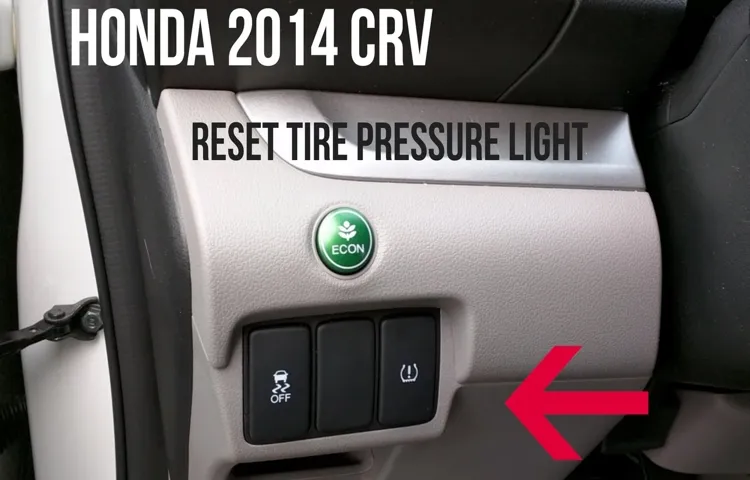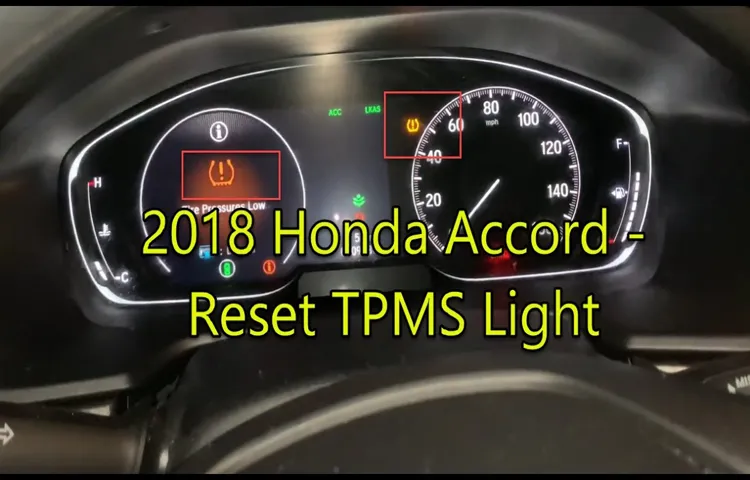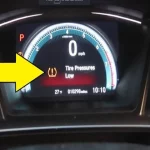Maintaining the recommended tire pressure in your Honda Accord is crucial for its performance and to ensure the safety of your passengers. Driving with underinflated or overinflated tires can lead to poor handling, reduced fuel efficiency, increased wear and tear on your tires, and even accidents. If you’re unsure of how to check tire pressure on your Honda Accord, don’t worry; it’s a simple process that you can easily do on your own.
In this blog, we’ll guide you through the steps of checking your tire pressure and give you some tips to ensure consistent tire health over the long run. So, whether you’re going on a long road trip or driving to work, you can always be confident that your Honda’s tires are in their best condition.
Table of Contents
Why Checking Tire Pressure is Important
If you own a Honda Accord, it’s important to check your tire pressure regularly to ensure that your car is running safely and efficiently. Checking your tire pressure is a simple process that can be done at home with a tire pressure gauge, which you can usually find at any auto supply store or online. Simply remove the valve cap from each tire and insert the gauge into the valve stem to take a reading.
Your Honda Accord’s recommended tire pressure can be found in your owner’s manual or on the tire information label located on the driver’s side door jamb. It’s important to check tire pressure when your tires are cold, meaning they haven’t been driven on for at least a few hours. If your tire pressure is below the recommended level, you can easily add air using a tire inflator or by visiting a gas station equipped with an air pump.
Not only will properly inflated tires improve your car’s handling and fuel efficiency, but it will also extend the life of your tires and reduce the risk of blowouts or other tire-related accidents on the road. So be sure to check your Honda Accord’s tire pressure regularly for a safer and smoother driving experience.
Improves fuel efficiency and saves money
Checking tire pressure is incredibly important as it can improve your car’s fuel efficiency, ultimately saving you money. When your tires are underinflated, it causes more friction between the tires and the road, making the engine work harder to keep up with the speed. By keeping your tires at the recommended pressure levels, you can reduce the amount of resistance and friction, which will lead to improved fuel economy.
In fact, studies have shown that keeping your tires properly inflated can improve gas mileage by up to 3%. That might not sound like much, but over time, it can add up to a significant amount of savings.
So, taking a few minutes out of your day to check your tire pressure and inflate them to the correct level can go a long way in improving your car’s performance and saving you some cash. Remember, a little bit of effort can go a long way in maintaining your car’s health and keeping your pocketbook happy.

Extends the lifespan of tires
Checking tire pressure regularly is crucial in extending the lifespan of your tires. When tires are underinflated, they experience more friction and heat, which leads to faster wear and tear. Moreover, underinflated tires cause your vehicle to consume more fuel, as they require a greater amount of energy to move.
Conversely, overinflated tires have less contact with the road and are more prone to punctures, which can shorten their lifespan. Therefore, maintaining the recommended tire pressure not only ensures a smoother and safer ride but also drastically reduces the frequency of tire replacement. It is recommended to check tire pressure at least once a month, using a tire pressure gauge, or visiting a professional mechanic who can do it for you.
Investing a little time in tire pressure maintenance can go a long way in saving both money and the environment.
Improves overall safety while driving
Checking tire pressure is an essential aspect of car maintenance that can positively impact driving safety. Driving with underinflated tires can lead to decreased fuel efficiency, increased wear and tear on tires, and a higher risk of accidents. When a tire has low pressure, it creates more friction between the road and the tire surface, resulting in the tire overheating and potentially leading to a sudden blowout.
Additionally, underinflated tires affect vehicle handling and braking, increasing the likelihood of skidding or losing control of the car. Consistently checking tire pressure and maintaining proper levels not only improves driving safety but also extends the life of tires and contributes to better fuel economy. So, to ensure a smooth and safe driving experience, it is essential to make tire pressure checks a regular part of your car maintenance routine.
Gather Necessary Tools and Material
Before checking the tire pressure on your Honda Accord, it’s essential to gather all the necessary tools and materials. You will need a reliable tire pressure gauge, an air pump, and your vehicle’s user manual, which will provide you with the recommended tire pressure for your specific vehicle model. Having all these items at hand beforehand will ensure a seamless process and accurate readings.
It’s important to note that tire pressure can fluctuate depending on weather conditions and usage, so regular checks are crucial for optimal driving performance and safety. So, make a habit of checking your Honda Accord’s tire pressure regularly and maintaining it at the recommended level, ensuring a safe and smooth ride wherever you go.
Tire Pressure Gauge
When it comes to checking your tire pressure, the most important tool you’ll need is a tire pressure gauge. Now, you might be wondering what kind of tire pressure gauge to get, and that’s a fair question. An analog gauge is great for those who prefer a classic, no-fuss design, while digital gauges offer a more precise reading.
In addition to a gauge, you’ll also need a tire inflator or air compressor to actually adjust the pressure if needed. Some inflators come with built-in gauges, which can be convenient. Finally, it’s important to make sure you have the owner’s manual for your vehicle on hand, as it will provide you with the recommended tire pressure range for your specific make and model.
Having all of these tools and materials ready to go will make the tire pressure checking process quick and easy.
Pencil or Paper
When it comes to choosing between pencils and paper, it’s important to gather the necessary tools and material to ensure your creative process goes smoothly. If you’re someone who prefers a pencil, you’ll want to have a variety of pencil grades on hand, from soft to hard, to create different levels of shading and texture in your art. You’ll also want to consider the type of paper you’re using – thicker paper can handle more pressure and layers of pencil, while thinner paper may work better for detailed line work.
On the other hand, if you prefer paper and pen, you’ll want to select the right type of pen, such as a ballpoint or a felt tip, depending on the type of lines you’re looking to create. You may also want to consider the weight and texture of the paper, as each one will affect how the pen interacts with the surface. By taking the time to gather the right tools and materials, you can ensure that your creative process moves smoothly, and the end result is exactly what you envisioned.
Locate the Tire Pressure Monitoring System (TPMS) Button
If you’re wondering how to check tire pressure on your Honda Accord, one of the first things you need to do is locate the Tire Pressure Monitoring System (TPMS) button. TPMS is a helpful feature that alerts you when your tire pressure is nearing dangerous levels. To find the TPMS button, look for a small button with an exclamation point icon on your dashboard.
Depending on your Honda Accord model, it could be located on the dashboard or center console. Once you’ve found it, turn the ignition to the “On” position (but don’t start the engine) and press the TPMS button for a few seconds. This will activate the system and show you the pressure readings for each tire.
Keep in mind that proper tire pressure is crucial for optimal driving performance, so be sure to check your pressure regularly and fill up any low tires promptly to stay safe on the road.
Check Tire Pressure Using Tire Pressure Gauge
To ensure your Honda Accord is performing at its best, it is essential to regularly check the tire pressure. One of the most accurate ways to accomplish this is by using a tire pressure gauge. Begin by unfastening the valve cap and placing the gauge onto the valve stem.
Press down until no more air is escaping, then check the pressure reading on the gauge. If the reading is too low, use an air compressor to inflate the tire to the recommended level, which can be found in the owner’s manual or on the driver’s door jamb. If the reading is too high, use the gauge to release some air until you reach the ideal level.
Continue this process for every tire, including the spare, as it is vital for maintaining your vehicle’s safety and efficiency. Remember, a few minutes of checking tire pressure can prevent more significant problems such as blowouts or poor fuel economy. So, don’t wait until it’s too late- incorporate this simple habit into your routine to keep your Honda Accord performing at its best.
Remove valve cap of tire
Checking tire pressure is an essential part of vehicle maintenance. It ensures the safety of your vehicle and provides better handling and fuel efficiency. To check tire pressure, the first step is to remove the valve cap of the tire.
The valve cap is usually located on the top of the tire and can be unscrewed by hand. Once the valve cap is removed, you need to insert the tire pressure gauge into the valve stem. The gauge will then read the air pressure of the tire, which should be compared to the recommended pressure listed in the owner’s manual or on the tire information placard.
The recommended tire pressure varies by vehicle, so it’s crucial to check the specific pressure for your car. It’s vital to ensure that the tire pressure is accurate, as both underinflated and overinflated tires can lead to problems like a lack of grip, uneven tire wear, and even blowouts on the road. So, make sure that you check your vehicle’s tire pressure regularly and adjust it accordingly to ensure your safety while driving.
Press gauge onto the valve stem
Checking your car’s tire pressure regularly is essential for maintaining optimal driving conditions and safety on the road. To check the tire pressure, you need a tire pressure gauge. The first step is to press the gauge onto the valve stem, ensuring a tight seal.
A burst of air will release, and the gauge will display the tire pressure. The optimal pressure level depends on the type of vehicle, and the recommended levels are often indicated in the owner’s manual or on the tire itself. If the reading is higher or lower than recommended, you’ll need to add or remove air from the tire until it reaches the appropriate pressure level.
It’s a quick and easy task that can prevent costly damage to your vehicle and ensure a smooth driving experience. Don’t overlook the importance of checking your tire pressure regularly – it can make all the difference.
Write down the tire pressure reading
If you want to ensure optimal performance and safety while driving, it’s important to keep your tires properly inflated. That’s why checking your tire pressure regularly is crucial. One way to do this is by using a tire pressure gauge.
Simply insert the gauge into the valve stem of the tire and take a reading of the pressure. This reading will be displayed on the gauge and can be compared against the manufacturer’s recommended tire pressure, which is often found in the owner’s manual or on a sticker inside the driver’s door. Make sure to write down the tire pressure reading and inflate or deflate your tires as needed to maintain the proper pressure.
By taking the time to check your tire pressure regularly, you’ll not only increase your vehicle’s fuel efficiency but also ensure a smoother and safer ride.
Adjust Tire Pressure
Checking the tire pressure on a Honda Accord is a straightforward task that can help you avoid accidents and improve your car’s performance. You can easily do it at home with a tire pressure gauge, which you can purchase at any auto parts store. First, make sure your car has been parked for at least an hour and the tires are cold.
Look for the manufacturer’s recommended tire pressure on the driver’s side door or in your owner’s manual. Unscrew the valve cap on each wheel and press the gauge firmly onto the valve stem. The gauge will show you the current pressure, which you can compare to the recommended pressure.
If the pressure is too low, use an air compressor to fill the tire to the proper level. Be sure not to overinflate the tire, as this can be dangerous. Repeat this process for each wheel, and don’t forget to replace the valve caps.
Regular tire pressure checks can help you maintain your Honda Accord’s safety and efficiency, saving you money and hassle in the long run.
Compare the tire pressure reading to Honda Accord manual
When it comes to maintaining your Honda Accord, one important aspect to keep in mind is checking the tire pressure regularly. The tire pressure reading can be found in the owner’s manual or on a sticker on the inside of the driver’s side door. Make sure to compare the readings to see if the tire pressure needs adjustment.
An underinflated tire can lead to lower fuel efficiency, poor handling, and an increased risk of a blowout. On the other hand, overinflating the tires can cause a harsher ride and increase the risk of a puncture. Adjust the tire pressure according to the instructions in the owner’s manual and check the pressure again after a few hours of driving to ensure they are still at the correct level.
By keeping your tire pressure at the recommended levels, you’ll not only improve your fuel economy and handling but also prolong the life of your tires.
Inflate or deflate tire as necessary using air compressor or tire inflator
When it comes to tires, maintaining the correct air pressure is crucial for both your safety and the longevity of your vehicle. If your tires are over-inflated, they can become stiff and wear unevenly, leading to decreased traction on the road and a shorter lifespan for your tires. On the other hand, under-inflated tires can cause excessive heat buildup, which can lead to tire failure and blowouts.
That’s why it’s important to regularly check your tire pressure and adjust it as necessary. To do this, you’ll need an air compressor or tire inflator, which can be found at most gas stations and automotive stores. Simply refer to your owner’s manual or the tire information placard on your vehicle to find the recommended pressure for your tires, and inflate or deflate them as needed until they reach the proper level.
Remember to always check and adjust your tire pressure when your tires are cold, as heat generated from driving can increase tire pressure and give inaccurate readings. By staying on top of your tire maintenance and keeping your tires properly inflated, you can ensure a safer and smoother ride for you and your passengers.
Recheck Tire Pressure
If you own a Honda Accord, it’s important to keep an eye on your tire pressure. Not only can incorrect pressure lead to decreased fuel efficiency and tire longevity, but it can also compromise your safety on the road. Luckily, checking tire pressure is a simple task that you can easily do at home.
First, make sure your tires are cold, as driving on them can cause the pressure to increase. Then, locate your vehicle’s recommended pressure – this information can be found in your owner’s manual or on the driver’s side door jamb. Use a tire pressure gauge to check the pressure of each tire, and add air as needed to reach the recommended level.
Finally, recheck the pressure and adjust as necessary. With a little bit of attention and care, you can keep your Honda Accord in top condition and ensure your safety on the road.
Use tire pressure gauge to check pressure again
When it comes to checking tire pressure, it’s important to be thorough. Even if you’ve used a tire pressure gauge already, it’s a good idea to double-check to make sure your readings were accurate. To do so, simply reattach the tire pressure gauge to the valve stem and take another measurement.
If the pressure has decreased, it may signal a leak or other issue with the tire. If the pressure has increased, it may mean that the tire is overinflated, which can result in decreased handling and stability on the road. Remember to always consult your vehicle’s owner manual for the proper tire pressure levels, and adjust accordingly.
By taking the time to double-check your tire pressure, you can ensure that your vehicle is optimized for performance and safety on the road.
Make sure all four tires are at proper pressure levels
One of the most important things you can do to ensure your vehicle’s safety is to make sure all four tires are at proper pressure levels. It’s important to regularly check your tire pressure, as it can affect your car’s handling, braking, and fuel efficiency. Rechecking the tire pressure is essential if you’ve recently driven through rough or uneven terrain or if the temperature has drastically changed.
When your tires are underinflated, they can cause drag and increase your car’s fuel consumption, while overinflation can lead to a harsh, jarring ride. By maintaining the right tire pressure, not only will you keep yourself safe on the road, but you will also save money at the pump. So, make sure you check your tire pressure regularly, especially before a long trip or when the seasons change.
It’s a small but essential step that can help keep you and your passengers safe.
Conclusion
In conclusion, checking the tire pressure on your Honda Accord is a simple yet crucial task that can go a long way in ensuring the safety and longevity of your vehicle. Remember to first consult your vehicle’s manual for the recommended pressure levels, then use a high-quality tire pressure gauge to measure and adjust accordingly. And don’t forget to give your tires a pat on the sidewall for a job well done.
As they say, properly inflated tires keep you on the road and in control – and that’s something to inflate our egos about!”
Regular tire pressure check is crucial for safety, longevity and cost savings
Regular tire pressure checks are absolutely critical for maintaining both the safety and longevity of your vehicle’s tires, while also maximizing cost savings. Low tire pressure can cause a wide variety of issues from decreased handling, reduced fuel efficiency, and increased tire wear. In fact, according to the National Highway Traffic Safety Administration, underinflated tires are responsible for more than 700 fatalities and 33,000 injuries each year in the United States.
Additionally, overinflated tires can lead to a rough and unstable ride, resulting in tire blowouts and potentially dangerous accidents. The best way to avoid these issues is by regularly checking your tire pressure with a tire gauge and making any necessary adjustments. Not only will this help keep you and your passengers safe on the road, but it will also save you money in the long run by reducing the need for costly tire replacements and improving overall fuel efficiency.
So, take a few minutes each month to check your tire pressure, and stay safe on the road while saving money at the same time!
Following Honda Accord manual ensures proper maintenance of tires
One of the most crucial aspects of car maintenance is taking good care of your tires. When it comes to tire maintenance, the Honda Accord manual offers invaluable guidance. One of the things that the manual emphasizes is rechecking the tire pressure regularly.
This is because the pressure can fluctuate depending on factors like weather changes. Keeping the pressure at the correct level ensures that your tires last longer, and it also guarantees better performance on the road. You can accomplish this by investing in a reliable tire pressure gauge and checking your tires at least once a month.
This way, you’ll be able to catch any issues before they become major problems, and you’ll also save money on tire replacement in the long run. Properly inflated tires also aid in fuel efficiency, so it’s a win-win situation!
FAQs
What is the recommended tire pressure for a Honda Accord?
The recommended tire pressure for a Honda Accord is typically between 32 and 35 psi, depending on the model and year.
How often should I check my Honda Accord’s tire pressure?
It’s recommended to check your Honda Accord’s tire pressure at least once a month, or before long trips.
Can I rely on the tire pressure monitoring system in my Honda Accord?
While the tire pressure monitoring system in your Honda Accord can be helpful, it’s important to manually check your tire pressure regularly as the system may not always be accurate.
What tools do I need to check my Honda Accord’s tire pressure?
You will need a tire pressure gauge and an air compressor, or access to a gas station with an air pump.
Is it safe to drive a Honda Accord with low tire pressure?
No, driving with low tire pressure can lead to decreased fuel efficiency, tire wear, and even blowouts, which can be dangerous.
How do I know if my Honda Accord’s tires are overinflated?
Overinflated tires may have difficulty maintaining proper traction, may cause the vehicle to bounce or vibrate while driving, and can even lead to premature tire wear.
What should I do if my Honda Accord’s tire pressure is consistently low?
If your Honda Accord’s tire pressure is consistently low, you may have a leak in your tire. It’s recommended to have the tire inspected and repaired or replaced if necessary.



